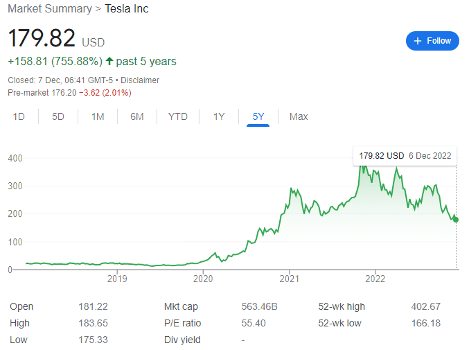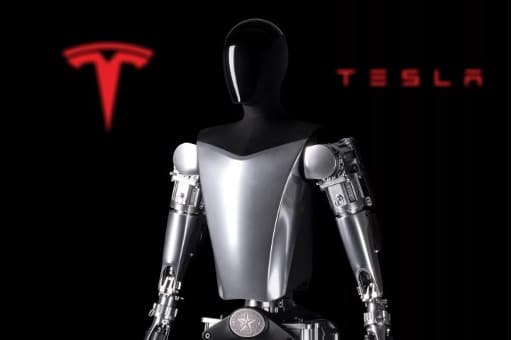Sino-US tensions, macroeconomic factors, shifting politics, increased competition, and Tesla’s pace of innovation all contribute to an increasingly complex investment case.
Tesla (NASDAQ: TSLA) shares are the long-term investor’s marmite. The EV stock’s market cap rose to more than $1 trillion last year with an all-time-high share price of $410 on a post-split basis by 4 November 2021.

However, the EV trailblazer’s stock has now fallen to $180 apiece. And based on publicly available data, its future trajectory remains far from certain.
1. Sino-US Tensions
Tensions between the US and China are simmering close to a boil. For years, the SEC and its Chinese equivalent have been arguing over US-listed Chinese stocks providing more information to the US as part of compliance regulations, an ask deemed too much by China in the name of national security. China’s position on the Ukraine War, and Nancy Pelosi’s recent visit to Taiwan, have only served to further inflame tensions.
With full-scale rioting rocking major cities in the face of the Communist Party’s ‘zero-covid’ policy, Shanghai, the largest port in the world, has faced a seemingly endless cycle of lockdowns. And with the country’s housing market on the edge — estimated to be worth up to 40% of annual GDP — President Xi Jinping has revealed that exports fell by 8.7% and imports by 10.6% in November, the worst performance in years.
This is a problem for Tesla, as its largest factory, and biggest revenue generator, is in Shanghai. Not only must it tread hot political water, but it must also contend with regular production shutdowns.
Reuters had reported that Model Y output would fall in the plant by more than 20% compared to November, a claim refuted as ‘untrue’ by management.
2. Macro Factors
Tesla is not immune to the macroeconomic factors sinking the Earth into global recession. Rising interest rates all over the developed world, coupled with surging inflation, is leading consumers to cut back on all non-essential spending.
Already, Tesla has started offering discounts to Chinese buyers, of some 6,000 Yuan to the end of the year, in addition to a previously announced 4,000 Yuan insurance subsidy and government incentives. It had already also cut prices for some models by up to 9% earlier in the year, facing slowing demand and elevated inventory levels.
While this has seen it deliver a record 100,000 EVs in China in November, continued discounting is also damaging its premium brand. Simultaneously, increased spending on raw materials such as copper, lithium, and nickel, in addition to rising personnel spending, is squeezing margins into 2023. With Tesla’s valuation based on exponentially increasing sales, a fall in sales in the new year could prove disastrous.
There’s also CEO Elon Musk’s acquisition of Twitter to consider; investors are split over whether the billionaire entrepreneur has acquired a $44 billion marketing department or is about to be embroiled in yet another SEC battle, and another distraction from the core business of selling cars.
It’s also worth considering Tesla’s overweight position in the NASDAQ 100, S&P 500, and hundreds of popular ETFs. As its share price falls, it accounts for a smaller proportion of index investor funds, creating a negative feedback loop of stock falls.
3. Shifting Politics
In the economic boom caused by ultra loose monetary policy, EVs were seen as a no-brainer step towards a greener world and more technologically advanced society.
The recent US Inflation Reduction Act has extended EV tax credits of up to $7,500 on qualified new EVs and hybrid vehicles through 2032. Moreover, the country plans for half of all new cars to be electric by 2030, is building 500,000 EV chargers countrywide, and has started a $3.1 billion plan to boost domestic EV battery production.Similar plans and policies are being implemented across both China and the western world.
However, EV scepticism is starting to creep in. In the UK, plans to start charging Vehicle Excise Duty on EVs are on the books as the government frets over how to fill the black hole in public finances. And privately, many question the practicalities of relying on the National Grid to charge millions of cars at a time, when blackouts are already a realistic possibility.
As boom turns into recession, the EV revolution may start to decelerate for a short time.
4. Competitors
Tesla is the original EV pioneer. But S&P Global intelligence data shows that Tesla’s grip of the global EV market has fallen by 79% to 65% over the past three years. And the analyst expects it to fall below 20% by 2025.
For context, Tesla at various points this year has been worth more than every other auto manufacturer in the world combined. But last month, EV brand BYD was the top-selling car brand in China, surpassing its elder brother. On other side of the Pacific, only 4% of US new car sales were electric in 2021, rising to 14% in the EU, with even higher proportions in China. The remaining 96% of new US car sales are predominantly made by Ford, Toyota, GM, and Chrysler, which comprises more than 60% of the country’s market share.
But these legacy giants are now shifting gear. GM and Ford alone will spend a combined $65 billion on EVs by 2025, leaving Tesla to combat competition on both sides of the Pacific.

5. Pace of Innovation
On the outside looking in, it appears that Tesla has further to fall in 2023. However, thousands of professional investors have shorted Elon Musk’s endeavours in the past and lost millions. This is the man who put an electric car on his own rocket and shot it into space for fun.
Tesla is years ahead of its competitors in terms of autonomous driving and has also launched its long-awaited semi-truck, with a 500-mile range. Despite being three years late, the new innovation could change the economics of cargo haulage permanently.
Then there’s the ‘Optimus’ humanoid robot, which Musk believes could one day eclipse the car sales business at Tesla. Non-believers may wish to recall similar scepticism when he promised to create reusable rockets, even after multiple failures. Now, SpaceX rockets are the NASA standard.
And with first-mover advantage, and a brand instantly synonymous with EV cars, Tesla may yet win the revolution.
This article has been prepared for information purposes only by Charles Archer. It does not constitute advice, and no party accepts any liability for either accuracy or for investing decisions made using the information provided.
Further, it is not intended for distribution to, or use by, any person in any country or jurisdiction where such distribution or use would be contrary to local law or regulation.